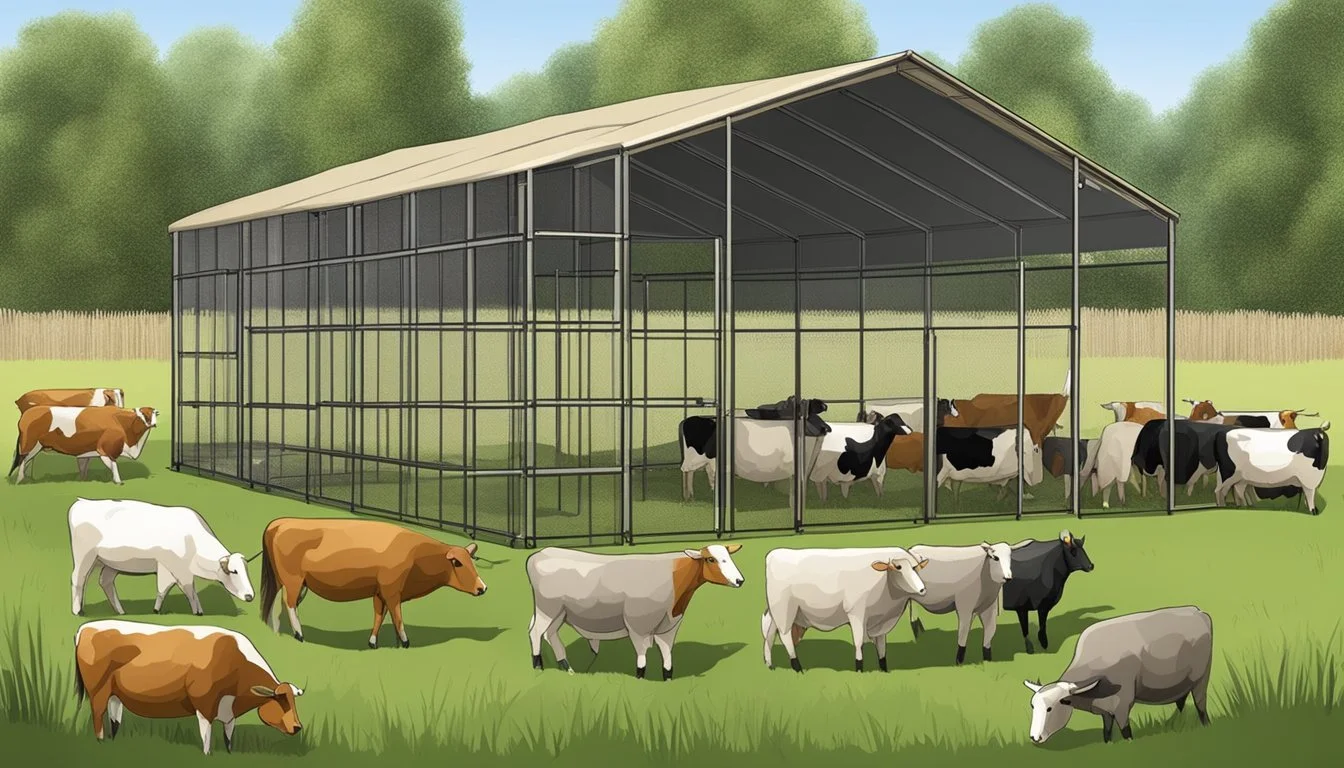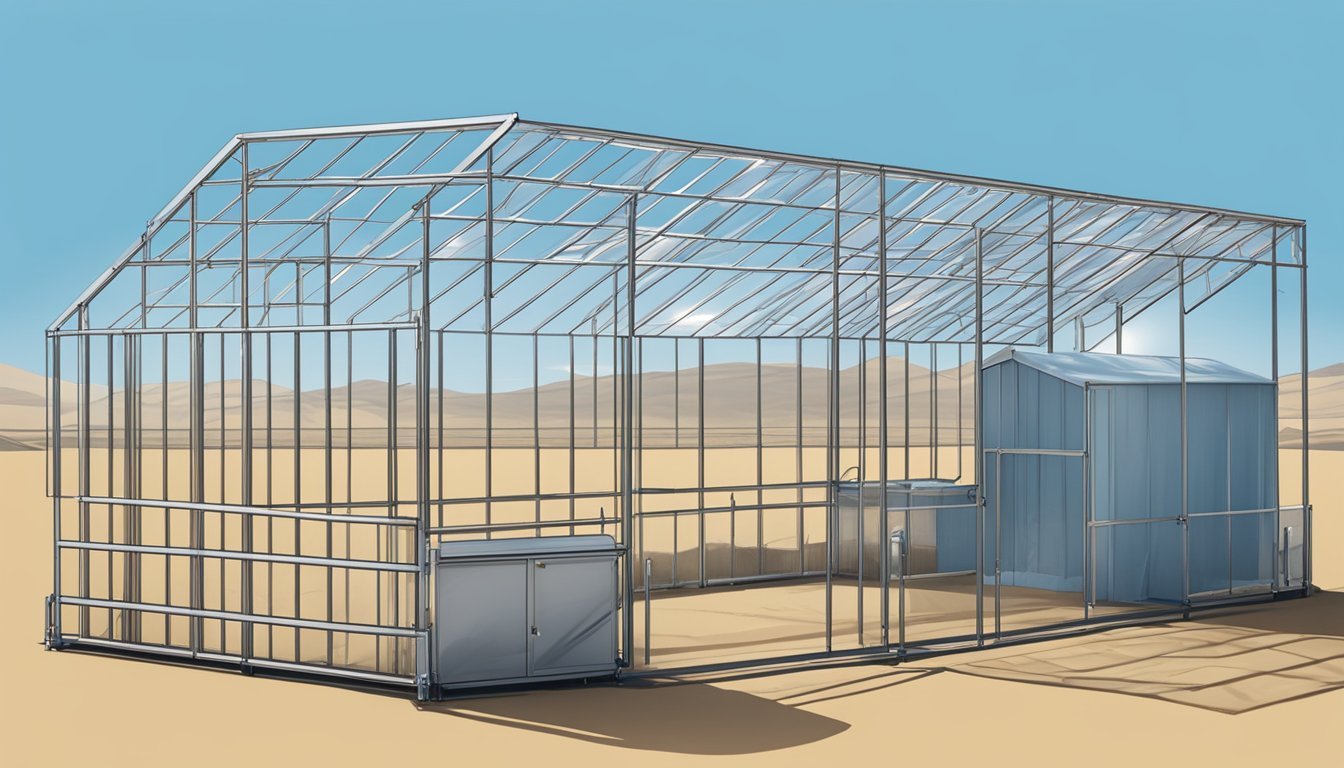Protect Your Livestock Anywhere with Portable Shelters
Essential Homesteading Solutions
Portable livestock shelters have become a pragmatic solution for homesteaders who aim to provide protection for their animals in a variety of settings. These structures offer flexibility and ease of movement, making them an ideal choice for rotational grazing or for land where permanent buildings are not feasible. With robust construction, these movable havens ensure that animals can be safeguarded from harsh weather conditions as well as predators, thereby prioritizing their well-being and safety.
The design of portable shelters typically incorporates durable materials capable of withstanding various elements and the wear from animal use. They often include features such as reinforced tarps or metal roofing and sturdy framing to offer reliable coverage. The adaptability of these shelters provides a cost-effective means to shelter livestock, whether it be for temporary grazing zones, calving areas, or simply as a retreat from inclement weather during outdoor roaming.
Moreover, the investment in a portable livestock shelter can enhance the operational efficiency of a homestead. They not only serve as a quick setup for emergent needs but also contribute to a more controlled and maneuverable farming environment. With the option to relocate these structures, farmers can optimize their pasture management and ensure that their livestock has access to clean and fresh areas, thus integrating good husbandry practices with innovative agricultural solutions.
Understanding Livestock Shelters
Providing the right shelter for animals is essential for their protection and well-being. Various shelters are tailored for different livestock needs including durability and mobility.
Types of Livestock Shelters
Livestock shelters come in multiple forms to suit various animal types and farm configurations:
Fixed Shelters: Traditional barns and sheds, which are sturdy and offer permanent protection against elements.
Portable Shelters: Versatile and can be relocated as needed to provide optimal shelter across different pastures or fields.
Specific shelters are designed for certain livestock:
Cattle: Larger structures with robust materials to withstand their size and strength.
Sheep and Goats: Smaller shelters that provide warmth and protection, often with easy access.
Horses: Spacious, well-ventilated shelters to accommodate their greater need for movement and air.
Pigs: Shelters that are easily cleaned and maintained, ensuring hygiene.
Chickens: Coops that protect from predators with options to move across pasture land.
Benefits of Portable Livestock Shelters
Portable livestock shelters provide a range of benefits:
Flexibility: They can be moved to various locations, aiding in pasture management and animal health.
Ease of Assembly: These structures generally require simple tools and can be quickly set up or dismantled.
Cost-effective: Lower initial investment compared to permanent structures and reduced maintenance costs.
Selecting the Right Shelter for Your Animals
When choosing a shelter, consider:
Size and Capacity: Ensure ample space for the number and type of animals.
Ventilation: Proper airflow is critical for animal health, particularly for horses.
Weather Resistance: Durable materials are necessary to protect against local weather patterns.
Ease of Access: For both animals and farmworkers, for maintenance and daily activities.
Select a shelter that balances the needs of your livestock with the practicalities of your farm operation.
Construction and Materials
The construction of portable shelters for livestock on homesteads is a critical task which revolves around selecting the appropriate materials and implementing design features to withstand various climate factors. Regular maintenance ensures the shelter's durability and longevity.
Choosing Suitable Materials
When building a portable livestock shelter, one must opt for materials that balance sturdiness with movability. The selection typically includes:
Wood: It serves as a robust framework material but can be vulnerable to termites; hence, pressure-treated lumber is advisable.
Roofing: Corrugated metal or tin is preferred for its durability and ability to deflect solar radiation.
Design Features for Climate Resilience
A portable shelter must be constructed to endure diverse weather conditions:
Snow: A slanted roof design prevents the accumulation of heavy snowfall.
Strong Winds: Anchoring mechanisms and a streamlined shape help resist strong wind forces.
Draft: Proper enclosure on the sides can protect livestock from cold drafts, while ensuring ventilation.
Maintenance and Durability
Regular maintenance of a portable livestock shelter is key to its durability. This includes:
Inspections for wear and timely repairs.
Treatment of wooden components to ward off termite infestation and decay.
By adhering to these construction and material guidelines, one's livestock can be efficiently protected in a portable and enduring homestead shelter.
Site Selection and Setup
Choosing the right location and preparing the site for a portable livestock shelter is critical. It ensures the health and comfort of the animals by providing a stable foundation, adequate ventilation, and effective drainage.
Evaluating the Best Location
A good location is paramount for the well-being of your livestock. The site should provide natural protection against prevailing winds and should be placed on higher ground to avoid water accumulation. Look for areas with ample grass coverage to prevent mud and ensure a hygienic environment. It's also crucial to consider the accessibility of the shelter for both the animals and farm operations.
Foundation and Anchoring
The foundation of a portable livestock shelter should be stable and level. Options such as concrete blocks or wood posts can be viable depending on the temporary or semi-permanent nature of the shelter. An effective anchoring system is essential to secure the shelter against strong winds and to maintain structural integrity.
Foundation Options:
Concrete blocks
Treated wood posts
Gravel beds
Anchoring Methods:
Auger-style anchors
Heavy-duty stakes
Earth anchors
Maximizing Ventilation and Drainage
Adequate ventilation is necessary to keep the air fresh and to minimize the buildup of moisture and harmful gases. Ensure that the shelter's design includes openings that allow for cross-ventilation without causing drafts in the resting areas. Proper drainage is vital to prevent water pooling which can lead to mud and potential health issues in livestock.
Ventilation Features:
Ridge vents
Side vents
Mesh panels
Drainage Considerations:
Sloped floors toward the entrance
Channels around the perimeter
Use of permeable bedding materials
Enhancing Animal Health and Safety
Portable shelters play a significant role in ensuring the health and well-being of livestock on a homestead. They provide a controlled environment that helps manage predator pressure, withstands adverse weather conditions, and supports regular animal monitoring.
Protecting Against Predators and Pests
Portable shelters act as a first line of defense against predators and pests that can threaten livestock. These structures can be equipped with secure locking mechanisms and sturdy materials to deter potential attacks. By using electrified fencing around the perimeter, the safety of the animals is further enhanced. For smaller pests like parasites, the shelters create a barrier that can be complemented by routine inspections and treatments.
Predator safeguards:
Locking mechanisms
Reinforced structures
Electrified fencing
Pest and parasite control:
Physical barriers
Regular animal inspections
Prophylactic treatments
Shelter and Seasonal Weather Conditions
Shelters provide livestock with a respite from harsh weather throughout the seasons. During summer, shelters offer shade and reduce heat stress, ensuring animals remain hydrated and less prone to heat-related illness. In winter, they serve as a warm refuge, protecting animals from cold and frostbite. The materials of the shelter should include breathable, waterproof, and insulated options to adapt to varying climatic conditions.
Summer:
Shade provision
Ventilation
Winter:
Insulation
Windbreaks
Facilitating Veterinary Care and Monitoring
The confined space of a portable shelter simplifies routine check-ups and emergent veterinary care, critical for maintaining livestock health. Proximity to the animals allows for easier observation, early detection of potential illness, and swift intervention. The shelter can also offer a dedicated space for administering treatments, vaccinations, and other veterinary procedures.
Veterinary interventions:
Ease of access for treatment
Controlled environment for monitoring
Practical Management Tools
Portable livestock shelters are versatile solutions that not only provide immediate protection for animals but also offer practical management tools for homesteaders. These shelters enhance the efficiency of operations, from secure storage strategies to facilitating rotational grazing and enabling easy transportation.
Storage Solutions for Feed and Equipment
Tack Room Integration: Homesteaders can dedicate an area within a portable shelter as a tack room. This room can be organized with shelving units and storage bins to keep feed, supplies, and equipment dry and out of the elements. The use of lockable cabinets ensures security and safety, particularly for items that require restricted access.
Feed Storage: To maintain the freshness and nutritional value of animal feed, airtight containers and raised pallets prevent moisture and pests from compromising feed quality. Homesteaders might consider weather-resistant materials for longevity and durability in their storage solutions.
Integrating Shelters into Rotational Grazing Systems
Efficient Land Use: Portable shelters are an asset within rotational grazing systems, providing flexibility in pasture management. They can be moved periodically to new grazing zones, allowing for land recovery and re-growth in previous areas.
Animal Well-being: Shelters strategically placed in grazing zones give livestock access to shade and protection from adverse weather, which can reduce stress and improve overall health.
Transportation and Relocation Convenience
Movable Designs: The incorporation of wheels or skids beneath portable shelters grants homesteaders the ability to relocate structures easily. This feature is particularly valuable when adjusting to season changes or altering farm layouts.
Multiple Uses: Besides serving as livestock enclosures, these shelters can also be converted into storage spaces for farm machinery or hay during off-seasons or when rotational grazing is not in practice.
By treating portable shelters as pivotal elements in their operational strategy, homesteaders can maintain a robust and adaptable system that caters to the dynamic nature of homesteading.
Financial and Ecological Considerations
When homesteaders look for portable shelter solutions, two critical aspects to consider are the financial implications and the ecological impact. Getting the balance right ensures long-term sustainability, both economically and environmentally.
Cost-Effective Shelter Solutions
Portable livestock shelters offer considerable cost savings, particularly when it comes to delivery and setup. These structures are typically designed to be lightweight and easy to assemble, minimizing transport costs. In addition, they often require fewer materials and can incorporate recycled components, reducing initial investment.
Initial Costs: Purchase price; delivery fees.
Ongoing Costs: Maintenance; potential moving expenses if relocating.
Savings: Reduced construction and installation costs compared to permanent structures.
The adaptability of portable shelters also contributes to their cost-effectiveness. They can be repurposed for different livestock or storage needs, maximizing their utility without necessitating additional expenditure.
Environmental Impact and Sustainability
The ecological consideration of portable shelters cannot be overstated. Homesteaders often prioritize sustainable practices, and portable shelters align with this ethos. By utilizing fewer resources, these shelters can mitigate the environmental footprint compared to traditional buildings.
Materials: The use of sustainable materials, such as locally sourced wood or repurposed metal, lessens the ecological impact.
Land Use: The mobility of portable shelters allows for rotational grazing, which can promote natural fertilization and prevent land degradation.
Habitat Preservation: Minimally invasive setup helps maintain natural landscapes and wildlife habitats.
Moreover, by choosing materials and designs that complement the local environment, homesteaders can further minimize their shelters' ecological impact, enhancing the overall sustainability of their operations.
Customization and Accessories
Customizable portable shelters offer the flexibility to meet the unique requirements of various livestock, ensuring their protection and comfort. Adding the right accessories enhances functionality tailored to specific needs.
Modifying Shelters for Specific Livestock Needs
When dealing with various types of livestock, shelters can be modified to cater to the distinct necessities of each species. For horses, an enclosed shelter with proper ventilation doors is crucial to provide airflow while offering shade and protection from elements. Owners should consider the installation of kickboards and chew guards to prevent damage from horses that might chew on wood or kick the walls.
For smaller livestock like goats or sheep, it can be beneficial to alter the entrance dimensions to prevent larger predators from entering. Using cattle panels, one can create a robust frame that conforms to the size of the animal, maintaining security and ease of movement.
Adding Functionalities with Attachments
Attachments are essential in augmenting the shelter's utility. For example, adding a tarp over cattle panels creates a lightweight and water-resistant roof, while reflective materials can enhance temperature control within the structure. The following list outlines some key attachments that can be added:
Doors: Attachable doors can be added for extra security and to control access to the shelter.
Roofing Materials: Options like corrugated metal, tin, or even specialty tarps.
Sidewalls: Enclosure kits or custom side panels offer additional protection from the weather.
Enclosed shelters can be further accessorized with feeders, water troughs, and storage areas for tack or feed, transforming a simple cover into a comprehensive care station for livestock. Flexible options allow them to be easily added or removed according to seasonal needs.
Planning for Expansion and Scalability
When selecting portable livestock shelters, farmers prioritize scalability and flexibility to accommodate growing herds and various types of animals. The right shelter solutions provide safety and comfort while offering the adaptability needed for changing farm requirements.
Adapting to Growing Herds and Diverse Livestock
Farmers must consider both the present and future size of their herds. A shelter that is ideal for a small number of animals may become inadequate as the herd grows. For diverse livestock, the shelter should allow for different spacing and partitioning to house animals such as horses, cattle, goats, and sheep comfortably. The ability to adapt to various animal sizes and behaviors is crucial for the safety and comfort of the livestock.
Current herd size: Ensure enough space for each animal.
Future herd growth: Plan for an increase in animal numbers.
Livestock diversity: Design for different species' needs.
Modular Design for Easy Expansion
Portable shelters, such as loafing sheds and run-in sheds, often come with a modular design that simplifies expansion. This enables farmers to start with a small shelter and then add additional modules as the herd expands or needs change.
Ease of Expansion: Modular units can be joined or stacked.
Customization: Configure layouts to meet specific requirements.
Efficiency: Avoid the need for new construction with add-on units.
By selecting a shelter with a modular design, farmers can ensure that their investment is protected as they can easily expand their structures to accommodate a growing herd or adapt to new livestock without the need for significant additional resources.
Legal and Regulatory Compliance
When setting up portable shelters for livestock on a homestead, it is crucial to navigate the maze of legal and regulatory compliance. This includes adhering to local zoning laws and building codes as well as maintaining high animal welfare standards to ensure the well-being of the animals and adherence to legal obligations.
Zoning Laws and Building Codes
Homesteaders must confirm that the placement and construction of portable livestock shelters comply with local zoning laws. These laws determine where agrarian structures like barns can be situated on a property. Additionally, building codes dictate specific requirements regarding the design and construction to ensure safety and suitability for the intended use. Failure to comply may result in fines or the need to dismantle non-compliant structures.
Checklist for Compliance:
Verify local zoning restrictions for agricultural buildings.
Address setback requirements from property lines and other structures.
Ensure the shelter meets structural safety standards.
Acquire necessary permits prior to construction or installation.
Animal Welfare Standards
The shelters must also meet established animal welfare standards. This includes providing sufficient space for each animal, adequate ventilation, and protection from the elements. Barns and shelters should be designed to be predator-proof to safeguard livestock from potential harm.
Key Points for Animal Welfare:
Deliver adequate shelter space per animal based on species-specific guidelines.
Design structures for proper ventilation and temperature control.
Incorporate preventative measures against predators.
Regular inspections for maintenance and repair to sustain a safe environment.









